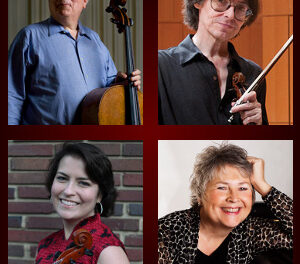After 20 seasons, the artists of the Mallarmé Chamber Players continue to set examples of what community-based non-profit musical organizations can accomplish. This is true despite the fact that they stubbornly break all the accepted rules and myths regarding what makes a successful run in a business that sees much failure. While they do not shy away from the great traditional chamber repertoire that concertgoers love to hear, Mallarmé’s eclectic and inventive programming is presented in ways attract even those die-hard “new music, no thanks” souls. On September 19, they kicked off their 21st season, in the Nelson Music Room at Duke University. This was a very special occasion because it harkened back to their very first concert in 1984. Artistic Director and flutist Anna Ludwig Wilson made some introductory remarks and reminisced about that first step. At that inaugural event, Mallarmé played William Walton’s Façade, which was also played on the second half of this celebratory program.
In line with their stated purpose and raison d’être , the program presented a collection of works that were new to most of the audience and to many of the musicians, some of whom played compositions they had never performed before. The afternoon began with a sadistic piece of finger gymnastics written in 1997 by William Bolcom for Sergiu Luca and Rolf Dieltens. This Suite for Violin and Violoncello is one of those works that should have a warning on its parts that says “only serious virtuosi need apply.” With cellist Fred Raimi and violinist Richard Luby we have two musicians who easily qualify, and they treated us to a bravura performance. This is a five movement work that roughly resembles the form of a baroque suite. The admonition to the composer by the cellist for whom it was written – “not to spare the players” – was certainly taken for its full effect. Just when you think that you have seen, heard and/or negotiated all (or at least most) of the devilish technique on an instrument, along comes a work like this. Raimi and Luby have an obvious rapport and great sense of communication, and they did not let the technical difficulties of the work get in the way of the musical structure. Like many unfamiliar scores, it is hard to get a good handle on it at first hearing, but this is definitely a piece that deserves more exposure in the future.
There was no respite for Raimi as he was next joined by Thomas Warburton, piano, Anna Ludwig Wilson, flute, and Michael Cyzewski, clarinet, in “Tapestry,” by Benjamin Lees. This work, barely one year old, is a longish one-movement composition that continually uses small thematic cells to build longer ideas and textures – certainly not a new idea and one that may describe many scores. The instrumentation used is relatively rare, and balance was a major challenge for both composer and performers. Warburton, the pianist, had the potential to drown out the other three, but he controlled his dynamics quite effectively and the result was a beautifully blended ensemble.
Without disparaging the two works on the first half, the main attraction was a reprise performance of one of the most colorful and interesting works I have heard in a long time: Façade: An Entertainment, by the great British composer William Walton. He was not always considered a force in British music, and in fact he failed his exams at Oxford. After that disappointment he spent his time in what can best be described as an artists’ colony where he was exposed to avant-garde musicians, writers, and painters. It was there that he composed Façade as an “entertainment for artists and people of imagination.” Indeed it is. The text comprises Symbolist-influenced poems based on rhythm and onomatopoeia (very appropriate since Mallarmé takes its name from the French symbolist poet Stephen Mallarmé). The work, in its present form, consists of 21 poems of varying lengths, accompanied by a musical ensemble of percussion, cello, saxophone, trumpet, flute, and clarinet. It was conducted by Susan Klebanow, director of choral activities at UNC-Chapel Hill. The poems were recited by Christine Morris and Clay Taliaferro. The former, dressed in the style of a 1920s flapper, and the latter, elegantly attired in a gray and black tuxedo, would have had a nice fat check, if paid by the word, because the text, printed in full in the program, took up twelve full pages. I was able to hear Morris quite well, but unfortunately I had a great deal of trouble understanding Taliaferro’s deep bass voice. (It could have been where I was sitting or the extra bass setting of the sound system.) The music, steeped in the culture of the 1920s, evokes that era with many references to then-popular dances. Trumpeter Jim Ketch displayed great stylistic finesse and juggled the constantly changing calls for mute (on and off) with athletic grace. Other participants not previously named included saxophonist Ira “The Great” Wiggins, whose jazz background prepared him well for this remarkable score, and the aptly-named percussionist John Wacker. This was musical fun at its best, and it was obvious why Mallarmé chose it for their first program, back in 1984. Hopefully, its repeat will not serve as a bookend on this wonderful organization but just a reminder of what they stand for and the promise of at least 20 more years of inspired music to come.











